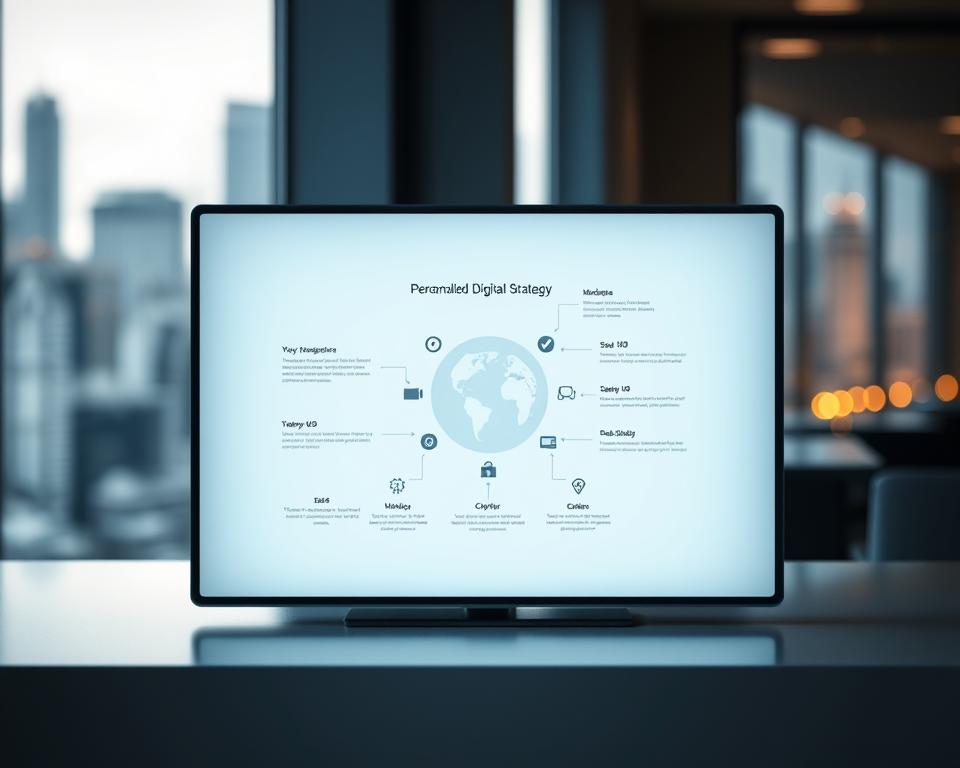The Transformation of Progression of Online Marketing: A Odyssey
Have you heard that over 170M individuals regularly engage with social media, effectively transforming the marketing landscape? As customers progressively transition to digital platforms, digital marketing has emerged as a crucial tactic. It enables companies to interact clients on platforms where they spend a significant part of their time. This transition marks the transformation of digital marketing from classic techniques to a more engaging and interactive approach.
With an approximate online advertising market worth of approximately two hundred billion dollars, it’s evident that West Palm Beach Digital Marketing Company must evolve to the continuing online marketing trends. This is essential to stay competitive in this rapidly changing environment.
The rise of online channels has enabled companies to reach markets that conventional advertising techniques have difficulty targeting. It’s no longer required when a single ad in a publication would suffice. Nowadays, targeted marketing strategies have become prominent, employing tools like search optimization, social media platforms, and collaborations with influencers.
As we examine the progression of online marketing, we will examine key milestones and tendencies. These have formed the current marketing paradigm. We will demonstrate the unprecedented opportunities and difficulties faced by companies in this digital era.
Main Points
- More than 170M individuals consistently interact on digital platforms, generating extensive promotional opportunities.
- Digital marketing is to be more affordable than classic approaches, facilitating broader reach with reduced costs.
- The worldwide online advertising market is expected to attain $517 billion by the conclusion of 2023.
- Precision strategies like SEO improve web visibility and interaction for brands.
- Digital influencers have established a one billion dollar industry, transforming brand advertising.
- Businesses leveraging mobile-focused marketing strategies can tap into the increasing consumer dependence on mobile devices.
- Allocating resources in online marketing tools, like AdWords, allows for exact targeting based on demographics.
Digital Marketing Basics
Online marketing covers a wide range of marketing activities across multiple online platforms. This covers social channels, email marketing, search platforms, and online sites. It’s a vital aspect of current marketing, due to the growing digital interaction between customers and brands. Businesses that comprehend the essentials of online marketing can create strategies that effectively connect with their intended audiences.
The progression of internet marketing is driven by evolving consumer behaviors. The emergence of mobile devices has changed promotion and sales. Nowadays, businesses employ multi-channel strategies to satisfy the needs of consumers who utilize various devices and platforms. Given the focus duration of Generation Y and Generation Z, content must be engaging and impactful from the start. Research indicate that incorporating videos can boost message impact by up to 300%.
The rising importance of digital marketing emphasizes the necessity to keep up of latest trends and technologies. Resources like artificial intelligence chatbots facilitate deep customer interaction, while social media influencers assist build trust with audiences. Classic advertising methods are no longer enough, emphasizing the importance of holistic digital strategies that meet today’s buyer needs.
| Factor | Information |
|---|---|
| Buyer Behavior | Shift towards digital engagement, reduced attention spans (12 seconds for Generation Y, 8 seconds for Generation Z) |
| Technology Usage | Rise of smartphones, expansion of interactive tech |
| Promotional Strategies | Emphasis on omni-channel and influencer marketing |
| Engagement Instruments | Employing artificial intelligence chatbots and video materials in marketing campaigns |
| Sector Evolution | Increase in digital advertising since 2000, emergence of PPC advertising with platforms such as Google AdWords |
What is Digital Marketing?
Digital marketing entails a range of approaches to engage audiences through digital channels. It includes search optimization, content strategies, and social media participation. The primary goal is to efficiently target and engage with target audiences using vast data and advanced technologies.
The increase of online advertising has been significant in the last few years. As organizations dig deeper into the online world, the need for effective online marketing tools grows. For instance, 53% of all web traffic is derived from organic search results, showcasing SEO’s importance in boosting visibility and website traffic.
Innovations in content marketing are crucial to a brand’s engagement with prospective customers. The content marketing industry is projected to reach two trillion dollars by 2032. It’s vital for companies to evolve their plans to efficiently leverage these programs. Compelling content builds bonds, improving customer loyalty and awareness.
Moreover, the significance of comprehensive Customer Relationship Management (CRM) tools has increased. Businesses that use customer insights can develop precision marketing campaigns. This leads to enhanced engagement and conversion rates.
In conclusion, online marketing is a evolving driver for businesses looking to boost their digital presence. By utilizing the newest in online advertising and innovative content marketing, brands can boost brand visibility and achieve greater customer engagement.
The Evolution of Digital Marketing
The marketing environment has seen a major shift over the years. The development of online marketing showcases how the web has transformed business communication with customers. As conventional methods turned old-fashioned, digital channels surfaced, providing new ways to connect with customers and track outcomes.
Moving from Traditional to Digital: A Key Transformation
The shift from classic to digital marketing has significantly transformed the advertising industry. Traditional methods like print advertising, radio media, and television presented restricted interaction. Digital advertising, however though, allows real-time engagement and analytics. The initial clickable banner advertisement in 1994 initiated the start of online marketing as we know it today.
This shift allowed businesses to test and refine their approaches, utilizing the online world to interact with consumers.
The Birth of the Internet and Digital Marketing
The rise of the internet ushered in a fresh marketing age. At first, businesses developed sites, laying the groundwork for online marketing. The end of the 1990s experienced the increase of search engines like Yahoo! and AltaVista, highlighting the need for SEO in online marketing.
This shift opened new avenues for accessing audiences actively looking for offerings, drastically altering customer-business relationships.
| Date | Milestone | Influence on Digital Marketing |
|---|---|---|
| 1994 | Initial clickable banner ad on HotWired.com | Foundation of online advertising |
| 1998 | Growth in search engine usage | SEO’s emergence as a marketing tool |
| 2002 | Google launches AdWords | Changed online advertising with PPC |
| 2004 | Facebook launched | Offered wide-ranging engagement opportunities |
| 2007 | Debut of the iPhone | Triggered the increase of mobile marketing |
| 2012 | Content marketing becomes recognized | Meaningful and significant content becomes vital |
The 1990s: The Dawn of Digital Marketing
The 1990s were a revolutionary period for advertising, setting the stage for current digital landscape. The inaugural website was launched in 1991 by Tim Berners-Lee, signifying a major change in brand-audience connections. Search engines became crucial for finding the growing online world.
Major Milestones of the 1990s
Several key moments shaped the 1990s, preparing the basis for digital marketing’s future:
- 1991: The introduction of the inaugural website sparked a increase in digital content interest.
- 1994: The debut of the first clickable banner ad paved the way to internet advertising.
- Early search engines like Archie search emerged, introducing users a means to search for digital information.
- Platforms like Yahoo Search grew, significantly influencing the digital user experience.
How Search Engines Impacted
The 1990s experienced a significant impact from search engines. As organizations realized the value of web visibility, SEO became crucial. Companies adapted to search algorithm updates to enhance their visibility to audiences. This indicated a shift from basic brand recognition to a focus on visibility and engagement, highlighting the essential role of search engines in digital marketing.
2000s: The SEO and Social Media Transformation
The 2000s witnessed a major shift in online marketing, driven by the increase in SEO and social media. Companies focused on boosting their online presence, causing a surge in SEO methods. These changes altered how businesses interact with audiences and how marketing strategies evolved.
Rise of Search Engine Optimization (SEO)
Companies realized the importance of search platforms as primary information providers. SEO turned into vital, with online platforms concentrating on information and keyword refinement. The early 2000s initiated PPC advertising, expanding digital marketing options. This laid the groundwork for advanced analytics and extensive data in marketing.
The Development of Social Media Platforms
Platforms like Facebook, Twitter, and LinkedIn became widely used mainstream, revolutionizing social media. They empowered companies to connect with users and offer focused advertisements. The late 2000s decade also witnessed the increase of mobile marketing, with the expansion of smartphones affecting strategies.
With exceeding one hundred seventy million daily users, social media’s impact on brand visibility was huge. Marketers started collaborating with influencers, increasing brand awareness and sales. Social media turned into a key part of modern digital marketing.
The Influence of Online Advertising Advancements
The digital marketing landscape has undergone a substantial transformation with the emergence of online advertising advancements. Programmatic advertising has transformed how brands interact with their audience. In the U.S., over 90% of digital display ads depend on programmatic methods for success. This development enables focused ad delivery, ensuring the correct message gets to the intended consumer.
Digital marketing trends show a rise in native advertising effectiveness. This approach, blending ads into user experiences, often surpasses traditional methods in engagement. Additionally, employing mobile app advertising has become crucial, accessing the viral capacity of these platforms to enhance visibility.
Augmented reality in content marketing is growing. It merges digital content with real-world environments, creating engaging experiences. Progressive web applications (PWAs) also focus on user experience, highlighting speed and clarity, fulfilling current consumer demands.
With nearly 315 million Americans engaged on social media in 2023, mobile optimization is more crucial than ever. A substantial portion of advertising budgets is dedicated to mobile ads, acknowledging the lengthy time users spend on their devices. This shift not only boosts user experience but also increases conversion rates, propelling revenue growth.
The integration of AI tools has significantly advanced online advertising. Tools like Albert permit predictive analysis for pay-per-click campaigns, aiding marketers improve strategies with real-time data. AI-driven automation enhances marketing efficiency, allowing brands to stay competitive in a quickly transforming market.
- Programmatic advertising boosts targeting efficiency.
- Native advertising often surpasses traditional methods.
- Augmented reality develops engaging marketing experiences.
- Mobile marketing focuses on optimizing user experience.
- AI tools offer predictive insights for campaigns.
Adapting to digital marketing trends ensures brands maintain competitiveness in the continually shifting digital landscape.
The Decade of 2010s : Period of Personalization
The 2010s decade experienced a significant shift in digital marketing, with a focus on personalization. Progress in data analytics allowed companies to adapt their marketing to match individual preferences and behaviors. This period highlighted the value of creating content that connects with users, enhancing engagement and loyalty.
Precision Marketing Strategies
Marketers in this decade looked to customer data to craft targeted campaigns. By comprehending consumer behavior, brands could send personalized messages on various platforms. Personalization efforts included:
- Dynamic website content that adapts based on user interactions.
- Personalized email campaigns customized for individual preferences.
- Behavioral retargeting ads that track users across the web.
This focus on targeted marketing helped brands connect with their audience more deeply. It led to higher customer satisfaction and conversion rates.
The Function of Data Analysis in Marketing
Analytics became crucial in the 2010s, helping businesses turn vast data into useful insights. Companies used analytics to track campaign success, user engagement, and predict future behavior. Key aspects included:
- Utilizing predictive analytics to anticipate customer needs and trends.
- Employing A/B testing to enhance advertising approaches based on real-time data.
- Integrating social media analytics to measure audience sentiment and preferences.
The rise of data analytics transformed how marketers strategized, enabling them to create more relevant and engaging experiences. This evolution set the stage for future trends, solidifying a customer-centric approach in digital marketing.
The Effect of Mobile Technology
The rise of mobile technology has significantly altered the digital marketing landscape. In recent years, the shift towards mobile devices, especially smartphones, has altered consumer engagement with brands and information access. By 2021, about 85% of Americans owned smartphones, a significant jump from 35% in 2011. This increase in mobile device usage has prompted changes in digital marketing strategies across various sectors.
As mobile technology evolves, brands have increased their investment in mobile ads. An amazing $7 out of every $10 spent on advertising now goes to mobile ads. In 2020, mobile ads made up around 70% of all internet ad revenues. This demonstrates a clear consumer preference for mobile-friendly experiences. Businesses have accordingly prioritized responsive web design and mobile optimization for seamless interactions.
- 15% of Americans rely exclusively on their smartphones for internet access.
- Mobile optimization has turned into essential for consistent user experiences across devices.
- Social media platforms like Facebook and Instagram have employed mobile technology to enhance brand visibility.
- Data-driven marketing strategies enable enhanced understanding of customer preferences.
The progression of digital marketing has also seen a change towards personalized and targeted marketing. This has caused better engagement and conversion rates. Analytics tools have turned into crucial for marketers looking to tailor their campaigns effectively. Innovations like virtual reality (VR) and augmented reality (AR) have opened new avenues for customer engagement, highlighting the dynamic relationship between mobile technology and digital marketing strategies.
Looking ahead, future trends will continue to merge technology and marketing innovation. Google’s decision to abolish third-party cookies in 2023 will necessitate businesses to adapt their smartphone marketing tactics. Ethical concerns around data protection will influence consumer trust and influence marketing practices. As consumer behaviors transform with mobile technology, brands must stay adaptable to seize emerging opportunities within the changing digital marketing landscape.
Present Digital Marketing Trends
The evolution of digital marketing is continuing, with several trends shaping how businesses interact with consumers. Artificial intelligence and machine learning are revolutionizing marketing strategies. These technologies facilitate more personalized experiences, resulting in higher engagement and conversion rates through data-driven approaches.
Social media platforms have experienced significant growth since their introduction in the mid-2000s. They have become essential for brand engagement, allowing businesses to connect with audiences on a personal level. Moreover, social media SEO is an emerging field, offering opportunities for content creators to improve their search engine rankings.
Video marketing is a leading technique, reflecting a preference for visual content. With growth projections, marketers must focus on creating video content to meet consumer demands.
Voice search optimization is another key trend, driven by the increasing use of voice-activated devices. Brands must adjust their content strategies to address voice queries, ensuring relevance as technology advances.
As data privacy regulations tighten, the digital marketing landscape will transform. Marketers must comply with these regulations while maintaining personalized experiences. Finding a balance between handling customer data and tailored marketing is crucial for engagement in this evolving digital world.
Google’s dominance in online information retrieval, with around 90% market share, highlights the need for perfecting SEO strategies in 2024. The change towards AI snippets and visual content is transforming SEO focus, demanding brands to improve their strategies in response.
| New Technology | Impact on Marketing | Consumer Engagement Potential |
|---|---|---|
| Generative AI | Boosts content production and personalization | High |
| Virtual Reality (VR) | Develops immersive experiences for users | Very High |
| Augmented Reality (AR) | Boosts product interaction through digital overlays | High |
| Internet of Things (IoT) | Links devices to gather user data for targeted marketing | Moderate |
As brands explore this new landscape, their ability to adapt will shape the future of digital marketing. Integrating these technologies is not just about keeping pace; it’s about redefining customer-brand interactions. This will create a more personalized and engaging marketing environment.
Closing Remarks
The development of digital marketing has been a process of constant innovation and adaptability. From the early internet days in the 1990s to today’s advanced strategies, businesses have always adapted. The rise of SEO, social media, and artificial intelligence demonstrates the need for marketers to keep up with new strategies to stay ahead.
In the 2010s, methods like Media Mix Modeling and Multi-Touch Attribution set new standards for measuring marketing success. The COVID-19 pandemic also highlighted how crucial digital channels are for businesses to reach their audiences. Adapting to these changes is essential for brands aiming to succeed in our digital-first world.
Therefore, businesses must be proactive and proactive in their digital marketing efforts. By integrating new technologies and trends, they can better connect with their audience. Adopting continuous change in digital marketing strategies will enhance brand visibility and build stronger connections with consumers in today’s interconnected market.



